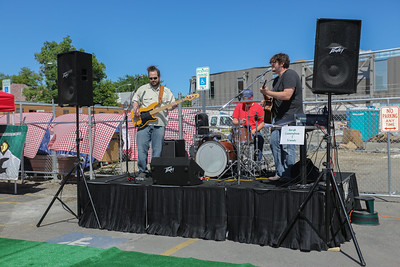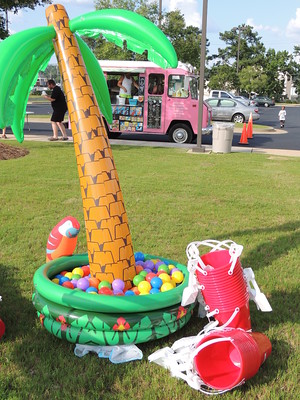Thinking Outside: Libraries and Placemaking in Pandemic Times
As libraries begin to consider offering services and programming in new or reimagined ways, some are looking at how to use outdoor spaces as a way to connect and engage with their communities. From parking lots to baseball diamonds, there are public spaces in every community that can provide ways for people come together, while remaining safely distanced.
Project for Public Spaces, an organization dedicated to helping people create and sustain public spaces that build strong communities, has been exploring ways that placemaking can help bring people together in outdoor spaces for many years, and the principles are especially important to libraries now, as we look for ways to move programming and services outside our traditional library spaces.
Outside the Box
 In 2014, OCLC, in partnership with Project for Public Spaces (PPS), led 22 public libraries through “Outside the Box,” a community initiative funded by Redbox. The training program explored placemaking principles and supported libraries as they planned community-wide, mostly outdoor events, bringing people together for free, fun entertainment events in their local community. WebJunction hosted a webinar with Elena Madison from PPS, Outside the Box - Placemaking, Partnerships & Community Event Design, which introduces placemaking and leads libraries through a step-by-step process of identifying potential public spaces, engaging the community in planning spaces and events, finding community partners, and using reusable materials and features to make the community space welcoming to all. A guide was also created to help lead libraries through the process: Outside the Box: A Guide for Placemakers (PDF - 46 pages).
In 2014, OCLC, in partnership with Project for Public Spaces (PPS), led 22 public libraries through “Outside the Box,” a community initiative funded by Redbox. The training program explored placemaking principles and supported libraries as they planned community-wide, mostly outdoor events, bringing people together for free, fun entertainment events in their local community. WebJunction hosted a webinar with Elena Madison from PPS, Outside the Box - Placemaking, Partnerships & Community Event Design, which introduces placemaking and leads libraries through a step-by-step process of identifying potential public spaces, engaging the community in planning spaces and events, finding community partners, and using reusable materials and features to make the community space welcoming to all. A guide was also created to help lead libraries through the process: Outside the Box: A Guide for Placemakers (PDF - 46 pages).
Transforming and Creating Smart Spaces
WebJunction also collaborated with PPS on the more recent Small Libraries Create Smart Spaces project, working with small and rural libraries to use placemaking principles to create active learning spaces in their libraries. The Wilton Public & Gregg Free Library chose to focus on an outdoor physical space for active learning and community engagement. The town of Wilton was planning to create a new Riverwalk Park across the street from the library as part of a wider effort to make the community more livable and convivial and so the library’s new outdoor space was a wonderful continuation of that public space. There is a free three-course sequence in the WebJunction Course Catalog, Making Space for Active Learning, that explores the concepts of active learning and placemaking, the tools and process for community discovery, design thinking principles for transforming spaces, and action planning and implementation for making the space and service transformation happen.
Prioritizing Public Spaces
As states begin to lift stay-at-home orders, public health officials encourage extra caution as we move about our communities and to take advantage of outdoor time whenever possible, as studies indicate that the coronavirus is less likely to spread outdoors. Project for Public Spaces, in new articles and recent webinars, is sharing insights on how to prioritize outdoor public spaces in upcoming community programs and services.
In The Recovery Will Happen in Public Space, Phil Myrick suggests, “To avoid a resurgence in infection and to recover equitably, cities must think more expansively about how all kinds of outdoor, everyday spaces can fulfill people’s daily needs, and work directly with the communities most affected by the virus and its economic fallout.”
And further,
“Free programming that can rebuild health and a sense of community could roll out of community centers and libraries and into neighborhood streets and parking lots. Imagine physically distanced exercise programs, walking groups, story time, and even outdoor theater and small concerts. Raised-bed planters of community-tended vegetables and flowers could sprout up in our underused streets and parking lots. Municipal services can also be brought into neighborhoods that lack the basics: meal distribution, temporary health clinics, temporary housing, and other social services.”
 With economic hardship and other social impacts from the pandemic, libraries anticipate increased needs in the community, especially from those struggling with housing. In the article, Homelessness & Public Space During COVID-19: Seven Takeaways, Nate Storring summarizes a recent two-part webinar series, When “Stay at Home” Isn’t an Option: Public Spaces and Homelessness During COVID-19 (view recordings: Part 1 and Part 2). Panelists from social service providers and public space managers discuss the challenges facing people without housing right now, and how the use of public spaces might address some of those challenges.
With economic hardship and other social impacts from the pandemic, libraries anticipate increased needs in the community, especially from those struggling with housing. In the article, Homelessness & Public Space During COVID-19: Seven Takeaways, Nate Storring summarizes a recent two-part webinar series, When “Stay at Home” Isn’t an Option: Public Spaces and Homelessness During COVID-19 (view recordings: Part 1 and Part 2). Panelists from social service providers and public space managers discuss the challenges facing people without housing right now, and how the use of public spaces might address some of those challenges.
In another PPS webinar, Reimagining and Repurposing Engagement during COVID-19, conversations focused on a variety of perspectives, tools and experiences related to engagement practices, given the challenges of COVID-19. Themes for the conversation were guided by questions from the registrants and included strategies for bridging from virtual engagement back to face-to-face community engagement, and how to utilize public space to the fullest. The panelists include considerations for those community members experiencing homelessness and those with intellectual disabilities.
As libraries look to ensure equitable access to their services and resources, consider how using outdoor public spaces can both build connections and meet urgent and growing community needs. Thank you to the Project for Public Spaces for these valuable resources.
Photos: courtesy of the Outside the Box project.
